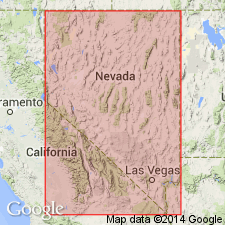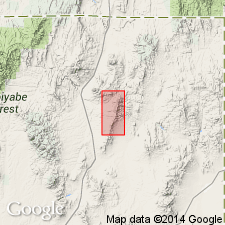
- Usage in publication:
-
- Valder Formation
- Modifications:
-
- First used
- AAPG geologic province:
-
- Great Basin province
Summary:
Pg. 585 (fig. 3), 587 (fig. 4). Comparison of Lower Paleozoic volcanic and non-volcanic geosynclinal belts in Nevada and Newfoundland. Valder Formation listed in table showing distribution of the sequences with argillites, cherts, and volcanic rocks in Nevada and Idaho. Thickness 100 feet. Overlies Cambrian. Below Agort Chert (new). Name credited to Riva (1966, in press). Present in northeastern Nevada. Age is Ordovician.
Type locality and origin of name not stated.
Source: US geologic names lexicon (USGS Bull. 1350, p. 793).

- Usage in publication:
-
- Valder Formation
- Modifications:
-
- Principal reference
- AAPG geologic province:
-
- Great Basin province
Summary:
Pg. opp. 2692, 2693 (table 1), 2695 (fig. 6). Valder Formation. Present in HD Range, northeastern Nevada. Overlies Noh Formation; underlies Noh Formation and Tiser Limestone (new). Age is Early Ordovician.
Type section: ____.
Source: GNC index card files (USGS-Reston).
For more information, please contact Nancy Stamm, Geologic Names Committee Secretary.
Asterisk (*) indicates published by U.S. Geological Survey authors.
"No current usage" (†) implies that a name has been abandoned or has fallen into disuse. Former usage and, if known, replacement name given in parentheses ( ).
Slash (/) indicates name conflicts with nomenclatural guidelines (CSN, 1933; ACSN, 1961, 1970; NACSN, 1983, 2005, 2021). May be explained within brackets ([ ]).

